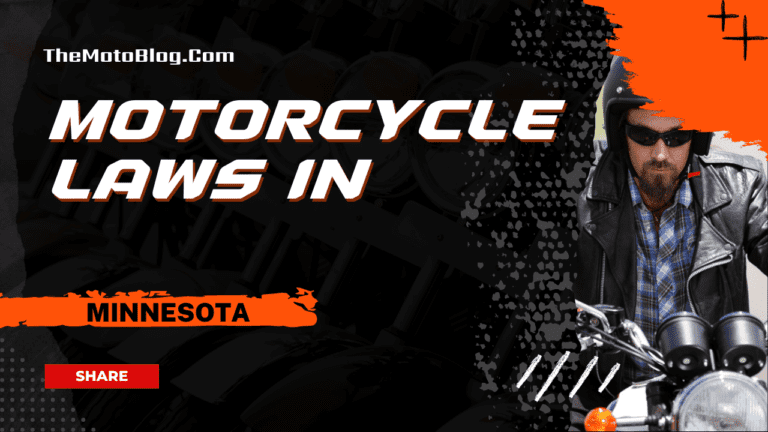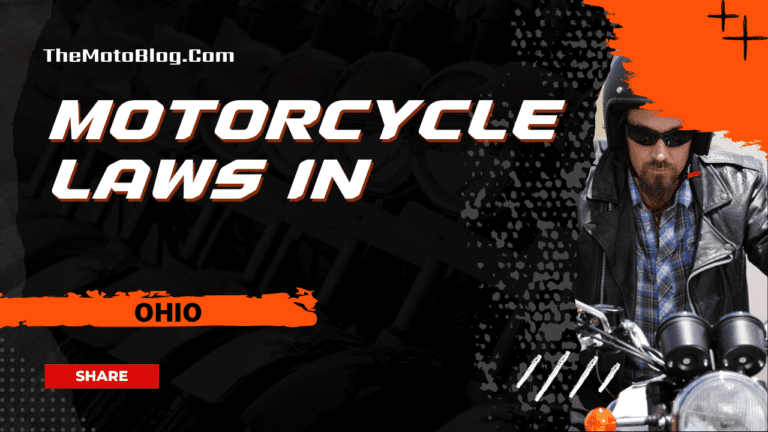Motorcycle Laws in Kentucky: A Comprehensive Guide for Riders
Motorcycle enthusiasts, take note – Kentucky law has some specific rules when it comes to hitting the road on two wheels. From helmet regulations to licensing requirements, there’s a lot you’ll need to know before you rev up your engine in the Bluegrass State.
First off, let’s talk safety gear. The state of Kentucky doesn’t mess around when it comes to protecting riders; if you’re under 21 or have had your motorcycle license for less than one year, a helmet is mandatory. Now that might seem restrictive, but it’s designed with your wellbeing in mind.
Next up: getting licensed. In Kentucky, you’ll need a separate motorcycle license or permit – even if you already hold a regular driver’s license. And getting that involves passing both written and skills tests specifically focused on motorcycle operation. So yes, you could say Kentucky takes its motorcycle laws seriously!
Key Takeaways
- In Kentucky, motorcycle riders under 21 years, or those who have held a motorcycle license for less than a year, must wear helmets.
- Kentucky requires every motorcycle to have at least one rearview mirror and to have its headlight on at all times.
- Motorcycle riders require a separate motorcycle license or permit in Kentucky, even if they already hold a regular driver’s license.
- Lane splitting is not allowed in Kentucky; riders must stick to their lane and maintain a safe distance from other vehicles.
- Motorcycle insurance is mandatory in Kentucky, with minimum required coverage for bodily injury and property damage.
- Kentucky is a ‘no-fault’ state, meaning each party involved in an accident seek compensation from their own insurance company. However, motorcycles are exempt from this no-fault law.
- Penalties for violating motorcycle laws include fines for helmet violations, criminal charges for riding without a Motorcycle Operator’s License (MOL), and fines for equipment violations.
- In the event of an accident, riders in Kentucky who were not wearing a required helmet could have their insurance claims denied due to non-compliance with safety laws.
- Kentucky law does not explicitly address lane splitting, leaving it as a grey area for riders.
- Any motorcycle passenger in Kentucky must ride behind the operator unless sidecar equipment is installed. Bikes carrying passengers must have footrests designed for them.
Motorcycle laws in Kentucky encompass various safety measures, including mandatory helmet usage for riders under 21 and for those holding a motorcycle instruction permit. There are distinctive contrasts and similarities when examining Kentucky’s neighboring states’ regulations. For instance, motorcycle laws in Ohio require helmets for novice riders and those under 18, whereas motorcycle laws in West Virginia enforce helmets for all riders. Moving south, motorcycle laws in Tennessee require helmets for all riders, while motorcycle laws in Virginia mandate helmets and have specific standards for protective equipment. Meanwhile, motorcycle laws in Indiana stipulate helmets for riders under 18 and those with learner’s permits. The motorcycle laws in Illinois require helmets for riders under 18. The varied regulations between Kentucky and its neighboring states accentuate the need for motorcyclists to be well-versed in specific laws, ensuring legal compliance and enhancing overall road safety.
The Basics of Motorcycle Laws in Kentucky
In the heart of America, lies the beautiful state of Kentucky. Known for its horse races and bourbon distilleries, this place also has a set of motorcycle laws that every rider should be aware of. Let’s dive into the basics.
First off, helmets are mandatory for all riders and passengers under 21 years old or who have held their motorcycle license for less than one year. It’s also required if you don’t carry medical insurance.
Then we’ve got eye protection. In Kentucky, if your bike doesn’t have a windscreen, you’re legally obliged to wear protective eyewear. And nope, sunglasses won’t cut it here folks! We’re talking about goggles or a face shield.
Let’s talk about insurance now. In our dear Bluegrass State, it is mandated by law to have liability insurance on your motorcycle at all times.
Here’s what minimum coverage looks like:
| Coverage | Minimum Required Amount |
|---|---|
| $15k per person bodily injury | $30k total bodily injury |
| $10k property damage |
But hey, these are just the bare minimums and getting more coverage may save you from financial headaches down the road.
Moving onto equipment regulations, there are some specific rules in place too:
- Your bike must have at least one mirror.
- Daytime use of headlights is not necessary but recommended.
- Handlebars can’t be higher than shoulder level.
- Turn signals aren’t required unless your ride was built after 1973 (a little vintage twist!).
Understanding Kentucky’s Helmet Laws
When you’re riding a motorcycle on Kentucky roads, it’s crucial to understand the helmet laws. I’ve been digging into these regulations and here’s what I’ve found out.
First off, Kentucky does not require all motorcyclists to wear a helmet. However, there are exceptions. For riders under the age of 21, helmets are mandatory whether you’re operating the bike or simply along for the ride as a passenger. It doesn’t matter if you have recently acquired your license or if you’re an experienced rider; if you’re under 21, you need to don that helmet.
The same rule applies for novice riders – anyone who has held their motorcycle operator’s license for less than one year is required to wear a helmet regardless of age. Also included in this group are those who have instructional permits.
Here’s how it breaks down:
| Age/Years Riding | Helmet Required? |
|---|---|
| Under 21 | Yes |
| Less than one year licensed | Yes |
| Instructional permit holder | Yes |
| Over 21 and more than one year licensed | No |
As far as equipment goes, not just any headgear will do. The law states that helmets must meet Federal Motor Vehicle Safety Standard (FMVSS) 218. This means they should have:
- A thick inner liner
- Riveted chin straps
- Weight of approximately three pounds
- Nothing protruding more than two-tenths of an inch from the surface of the helmet
My research also revealed some interesting points about insurance coverage in relation to wearing a helmet. If an accident occurs and the motorcyclist was not wearing a required helmet, insurance providers may deny claims due to non-compliance with safety laws.
How Lane Splitting Works in Kentucky
In Kentucky, lane splitting isn’t explicitly addressed in state law. That leaves it somewhat of a gray area for riders. Although it’s not directly permitted, there’s technically no rule saying that you can’t do it either.
Despite this ambiguity, it should be noted that just because something isn’t illegal doesn’t necessarily make it safe or advisable. Many argue that lane splitting can lead to accidents if drivers are unaware and change lanes without seeing an approaching motorcycle.
Here are some crucial points on road safety:
- Visibility – Motorcycles are less visible than cars due to their smaller size.
- Speed Difference – The speed difference between motorcycles and other vehicles can result in collisions during lane changes.
- Close Proximity – When riding between lanes, motorcycles are closer to other vehicles than usual which increases risk.
Safety experts suggest that bikers always ride defensively and follow these guidelines:
- Always wear safety gear
- Use turn signals for every lane change or turn
- Watch for changing road conditions
- Keep headlights on at all times
While we’re on the topic of laws related to motorcycles in Kentucky; helmets are mandatory for anyone under 21 years old or within their first year of licensure regardless of age.
Turning and Passing Rules on Motorcycles
Navigating the roads of Kentucky on a motorcycle is an exhilarating experience. But, it’s crucial to keep in mind the state’s specific laws regarding turning and passing. Let’s dive into some of these key rules.
Firstly, when making a left turn, it’s mandatory to approach in the extreme left-hand lane lawfully available. On multi-lane highways, you’re allowed to make such turns from any lane specifically designated for that purpose. It might seem simple enough, but forgetting this basic rule can lead to dangerous situations.
Next up: passing regulations. In Kentucky, motorcycles are treated like any other vehicle – meaning you’re not permitted to overtake another vehicle within the same lane (also known as ‘lane-splitting’). You’ll need your own lane to safely pass other vehicles.
Here are a few key points on Kentucky motorcycle laws:
- Left Turns: Must be made from the far-left lane unless otherwise specified.
- Passing: Lane-splitting isn’t allowed; you must have your own lane when overtaking another vehicle.
Now let me touch upon group riding which is popular among motorcyclists. When riding with others in a single file or side by side formation is legal here in Kentucky as long as traffic rules aren’t violated.
Finally, signaling intentions is crucial whether turning or passing. If your motorcycle doesn’t have signal lights or they are defective or damaged, hand signals may be used instead.
Motorcycle Equipment Requirements in Kentucky
When it comes to motorcycle laws, I’ve always found that Kentucky’s are particularly interesting. They have some unique equipment requirements that you should definitely be aware of if you’re planning a ride through the Bluegrass State.
First and foremost, helmets are a hot topic. In many states, wearing a helmet is optional for riders over a certain age. However, in Kentucky it’s mandatory for all riders under 21 years old or anyone who has held their motorcycle license for less than one year. Additionally, helmets must meet the standards set by the Federal Motor Vehicle Safety Standard #218.
Now let’s talk about mirrors and lights. Every motorcycle on Kentucky roads needs at least one rearview mirror and must have its headlight on at all times – not just at night! It may seem like overkill but these measures greatly enhance your visibility to other drivers.
Eye protection is another requirement in this state unless your bike is equipped with a windscreen. This can include goggles or glasses with safety lenses made from shatterproof material.
Here’s a quick rundown:
- Helmets: Required for those under 21 or licensed less than one year
- Mirrors: At least one required
- Headlights: Must be on at all times
- Eye Protection: Required unless equipped with windscreen
As far as passenger regulations go, any passenger must ride behind the operator unless sidecar equipment is installed. Furthermore, every bike carrying passengers needs to have footrests specifically designed for them.
Dealing with Accidents: A Biker’s Legal Rights in Kentucky
When it comes to motorcycle accidents, I’ve come across a number of cases here in Kentucky. It’s essential that riders know their rights and how the law protects them.
First and foremost, let me emphasize this – Kentucky is a no-fault state. This means your own insurance company will cover your medical expenses up to the limit of your policy, irrespective of who is at fault for the accident. However, you should be aware that this no-fault rule does not apply if you’re operating a motorcycle. Yeah, you read it right! As per Kentucky Revised Statutes 304.39-040(2), motorcycles are specifically excluded from the definition of “motor vehicle” for purposes of No-Fault coverage.
Moving on, let’s talk about helmet laws here in Bluegrass State. Helmets are mandatory for all riders under 21 years old or those holding an instruction permit and any passenger riding with them according to KRS §189.285(3).
| Age Group | Helmet Required |
|---|---|
| Under 21 | Yes |
| Over 21 | No |
For older bikers like me who have been licensed to operate a motorcycle for more than one year and any passengers riding with us – helmets become optional.
Should you find yourself involved in an accident while riding without a helmet (and you’re legally allowed to do so!), don’t worry about it affecting your personal injury claim against another driver at fault for causing the crash. According to KRS §411.107, failure to use safety equipment (like helmets) won’t lessen damages recovered unless such failure is found by court to be causal factor contributing to cause plaintiff’s injuries.
In case of severe injuries or wrongful death after a motorcycle accident caused by another party’s negligence though, legal recourse may involve pursuing compensation through a personal injury lawsuit beyond what’s covered by insurance.
Penalties for Violating Motorcycle Laws
The first thing on our list is helmet violations. In Kentucky, both operators and passengers are required by law to wear helmets. If this rule isn’t followed, riders can face fines of up to $100 for their first offense and as high as $500 for subsequent offenses.
| Offense | Potential Fine |
|---|---|
| First | Up to $100 |
| Second | Up to $500 |
Next up, we’ve got license violations. It’s a must-have in Kentucky – a specific Motorcycle Operator’s License (MOL). Operating without one then that’s an instant Class B misdemeanor charge with possible jail time and a fine ranging from $100-$250.
We also have equipment violations. These focus on ensuring your bike meets safety standards – think working turn signals, brake lights, rearview mirrors – the works! Failing here will result in fines similar to those of helmet violations.
Let’s not forget about speeding tickets either! They start at around $60 but can quickly escalate depending on how far over the limit you were going:
- 1-10 mph over: around $60
- 11-15 mph over: roughly $80
- 16-25 mph over: approximately $150
Lastly, riding under the influence is severely punished here in Kentucky. A first-time DUI offender would be looking at a minimum 48 hours jail time plus court costs and fees which could total more than $700.
In summary:
- Helmet violations carry hefty fines
- Without a Motorcycle Operator’s License (MOL), you’re risking criminal charges
- Keep your bike up-to-date with all necessary safety equipment
- Speeding quickly gets expensive
- Riding under the influence has harsh consequences
The Role of Insurance in Kentucky Motorcycle Law
Now, here is something critical you need to know: Kentucky is a ‘no-fault’ state. This means that regardless of who caused the accident, each party involved turns to their own insurance company for compensation.
What makes this interesting is that motorcycles are excluded from Kentucky’s no-fault law. So if I’m riding my bike and get hit by a car, my medical bills won’t be covered by Personal Injury Protection (PIP) unless I’ve specifically added PIP coverage to my motorcycle policy.
That brings us to another important point – minimum liability coverage. In Kentucky, every motorcyclist must have at least:
- $25,000 for bodily injury per person
- $50,000 for total bodily injury if multiple people are hurt in the accident
- $10,000 for property damage
These numbers may sound big but believe me when I say they can run out quickly if you’re involved in a serious crash.
Here’s a summary of these figures:
| Coverage | Minimum Required |
|---|---|
| Bodily Injury per Person | $25,000 |
| Total Bodily Injury | $50,000 |
| Property Damage | $10,000 |
It doesn’t stop there though! If I’m underinsured or hit by an uninsured driver while riding my bike around town – yep you guessed it – I’ll be left with those hefty bills unless I’ve taken out additional uninsured/underinsured motorist coverage.
Wrapping Up: Key Takeaways about Motorcycle Laws in Kentucky
I’ve spent a good deal of time delving into the motorcycle laws in Kentucky, and I’m here to share some key takeaways. Let’s start with the basics: helmets and eye protection are mandatory for all riders under 21, regardless of their experience or skill level. If you’re over 21, you’re not off the hook – if it’s your first year riding or if you only have a motorcycle instruction permit, that helmet isn’t optional.
Here’s another critical point: lane splitting isn’t allowed in Kentucky. You’ll need to stick to your own lane and maintain a safe distance from other vehicles on the road.
Motorcycle licenses in Kentucky aren’t just handed out either – there are specific requirements that must be met. These include passing both written and skills tests before you can ride solo.
Let me present some of this information more visually:
| Requirement | Age Group |
|---|---|
| Helmet | Under 21 |
| Eye Protection | Under 21 |
| No Lane Splitting | All Ages |
| Written & Skills Tests For License | All Ages |
Lastly, I’d like to stress how important it is to understand these laws thoroughly. They exist for our safety after all. So whether you’re an experienced rider or just starting out, make sure you know what’s expected of you before hitting those open roads!
Motorcycle Laws in the US By States
If you liked this article, then please subscribe to our YouTube Channel for more Bike Videos. You can also find us on Instagram, Twitter and Facebook.
Disclosure: As an Amazon Associate, I earn from qualifying purchases. Read more about Amazon Affiliate Disclaimer.

Vishwanath Mathpati
I am Vishwanath Mathpati, a full-time Blogger and Motorcyclist from Bidar, Karnataka. I love writing about my Motorcycles Stories and Riding Gears on this blog.
Know More About Me.







